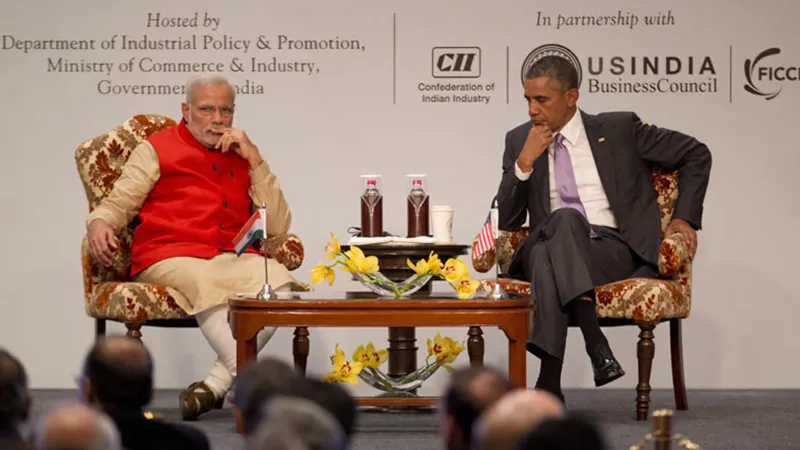As Prime Minister Narendra Modi and President Barack Obama joined the Republic Day celebrations and spent time with business leaders from the two countries, the rest of the world has begun to react to the full import of the emerging strategic partnership.
If Obama's presence on Rajpath today underscored the shared political values between the two nations, the military parade that he witnessed highlighted the growing prospects for a military partnership between the world's largest democracies. In noting India's continuing dependence on Russia for most of its military equipment, Obama would surely have seen the extraordinary potential of India as a military market when the US-built aircraft C-130s, P-8s and C-17s flew past.
As the third largest economy in Asia after China and Japan, India is of course more than a market for weapons. Delhi is increasingly seen in Washington as the lynchpin of any American strategy to secure a balance of power in Asia.
Modi, however, wants a defence relationship with America that goes beyond the buyer-seller relationship. He wants American defence corporations to come and make their weapons systems in India. Strengthening India's defence industrial base has been a major strategic objective for Modi, and was among the first sectors that his government liberalised.
Modi is also looking beyond the defence sector for a stronger trade and commercial partnership with America. At his interaction with the business leaders, along with Obama, he once again made a case for greater US involvement in India's economic growth.
The PM also articulated the inseparable link between business, geopolitics and shared values with America. In his address to business leaders, Modi said India is poised to emerge as the engine of growth in the region, "an important anchor of stability" in the world and a "force for peace" in Asia.
Modi argued that "as the two largest democracies, we have a fundamental stake in each other's success - for the sake of our values and our shared interests". Modi also outlined a fundamental change in the way India looks at America. "For too long, India and the United States have looked at each other across Europe and the Atlantic. When I look towards the East, I see the western shores of the United States."
That India and America are bound together in Asia and its waters was the main theme of a statement issued by the two leaders on Sunday. In a joint vision document on the Asia Pacific and Indian Ocean regions, Modi and Obama said "a closer partnership between the United States and India is indispensable to promoting peace, prosperity and stability in those regions".
Modi and Obama also agreed to "develop a roadmap that leverages our respective efforts to increase ties among Asian powers, enabling both our nations to better respond to diplomatic, economic and security challenges in the region". There was no mistaking that the case for an Asian coalition led by America and India is the rapid rise of China and its implications for regional security.
While the Chinese official reactions appeared cautious, the media commentary in Beijing has been quite sharp and was expressed along two very different lines. One was to dismiss the significance of Obama's visit to India by pointing to the enduring differences between Delhi and Washington. The other was to caution Delhi against drawing too close to America.
It was not probably a coincidence, but as Obama celebrated Republic Day in Delhi, Beijing was hosting the Pakistan army chief, Gen. Raheel Sharif, with great warmth. Chinese leaders told Gen. Sharif that Pakistan is an "irreplaceable, all-weather friend" of Beijing.
Much in the manner that the Sino-American détente transformed the Asian balance of power in the 1970s, the construction of a strong strategic partnership between India and America is bound to change the Asian geopolitical order and rejig the regional alignments.
But before one is carried away by the notion that India will be America's counterweight to China in Asia, it is important to remember that Washington's ties with Beijing are much thicker than those with Delhi. As Obama reminded Indian and American businessmen today, America's trade with China ($560 bn) is more than five times larger than that with India ($100 bn).
The message from Obama's second day in Delhi, then, is three-fold. One, India and America now find their shared political values more in tune with their strategic interests. Two, Modi and Obama have widened the scope for defence and security cooperation. Three, the two sides have their task cut out in strengthening the economic foundation of their incipient strategic partnership.
(The writer is a Distinguished Fellow at Observer Research Foundation and Contributing Editor of Indian Express)
Courtesy: The Indian Express, January 27, 2015
The views expressed above belong to the author(s). ORF research and analyses now available on Telegram! Click here to access our curated content — blogs, longforms and interviews.
